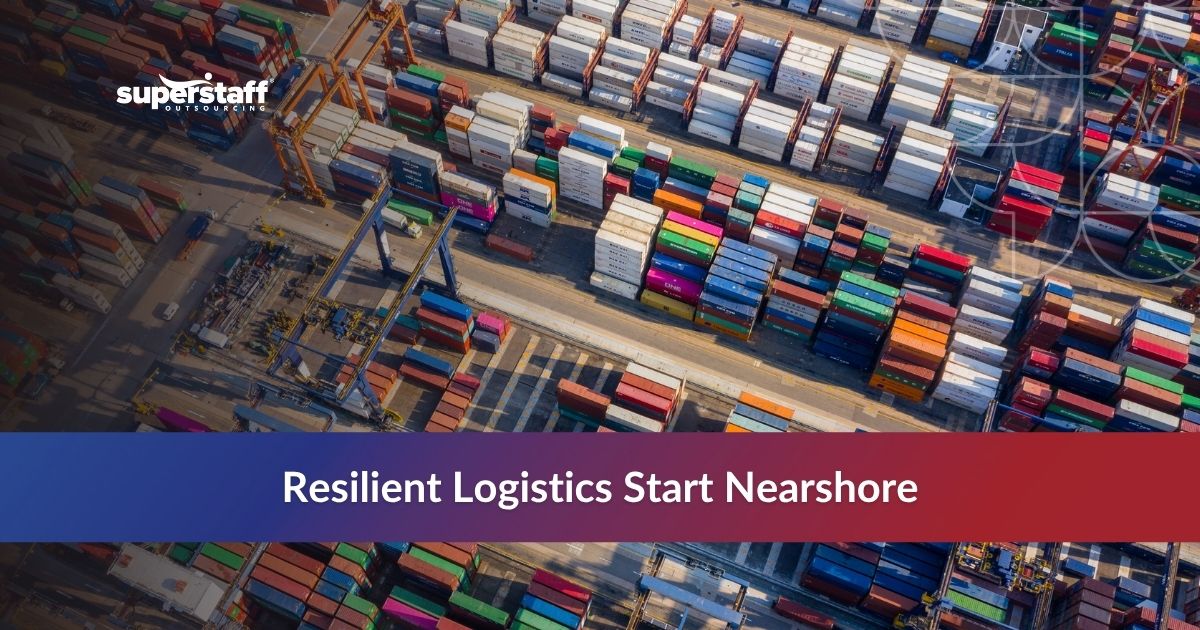
Supply chain resilience in 2025 is under pressure like never before. U.S. companies are walking a tightrope as tariff hikes and shifting global trade dynamics drive up costs and strain logistics operations. With protectionist policies escalating and geopolitical tensions disrupting traditional supply routes, the once-stable flow of goods has become unpredictable and expensive. Businesses can no longer depend solely on distant suppliers, long lead times, or complex customs processes.
To stay competitive, companies must rethink their global strategies. Nearshoring offers a practical path forward, bringing operations closer to home, particularly to regions such as Mexico and Latin America. This approach helps reduce tariff exposure, improve delivery timelines, and boost agility in responding to market shifts.
In this blog, we explore how nearshoring strengthens supply chain resilience in 2025, offering a smarter, more cost-effective way for U.S. businesses to navigate tariff-related disruptions and build lasting operational strength.
Tariff hikes are creating volatility across global supply chains.
Global supply chains are facing mounting challenges as tariff increases continue to reshape the international trade landscape. New and fluctuating duties on imports are not only raising costs but also complicating the logistics strategies amid tariff increases. U.S.-China tensions remain unresolved, with trade restrictions on key materials, including semiconductors, rare earth elements, and critical components, adding to the uncertainty.
Industries like automotive, electronics, and pharmaceuticals are particularly vulnerable. Higher tariffs on imported parts make it difficult to control costs while maintaining production timelines. These disruptions are often worsened by customs delays, port congestion, and forced rerouting to avoid additional fees, resulting in longer lead times and less predictable supply chains.
This level of unpredictability is prompting many U.S. companies to rethink their sourcing and production strategies. To navigate these challenges effectively, businesses are exploring more regional solutions that offer stability and speed.
Nearshoring offers a strategic alternative to traditional offshore production models.
One of the most promising responses to tariff volatility is nearshoring manufacturing and logistics. Instead of relying on suppliers halfway around the world, companies are relocating operations to countries geographically closer to the U.S. This shift reduces exposure to long-distance shipping delays and fluctuating tariff regimes.
Nearshoring destinations like Mexico, Colombia, and Costa Rica are experiencing increased investment due to their proximity, skilled labor, and trade agreements with the U.S. Mexico, in particular, benefits from the USMCA agreement, which offers more predictable trade terms and duty-free advantages for many sectors.
By nearshoring, businesses gain faster time-to-market, better communication due to overlapping time zones, and lower transportation costs compared to Asian markets. These factors combined offer a compelling advantage for U.S. companies looking to regain control over their supply chains.
Yet nearshoring is about more than just proximity. It’s a strategic shift toward building agile, efficient, and future-ready supply chains.

Nearshoring strengthens supply chain agility and resilience in unpredictable markets.
When it comes to supply chain resilience 2025, speed and flexibility are everything. Nearshoring to Latin America enables companies to respond promptly to changes in demand, new compliance regulations, and other external pressures. Being close to U.S. customers and facilities provides companies with the flexibility to pivot quickly, without incurring weeks of delay.
For example, reduced risk of border delays means that just-in-time (JIT) inventory systems are more viable, helping companies minimize inventory costs while staying responsive. Moreover, nearshoring facilitates compliance with rapidly evolving U.S. standards, including labor regulations and carbon footprint tracking.
This enhanced agility gives nearshoring a unique edge in today’s uncertain environment. It is no longer just a cost-saving measure but a core component of logistics strategies amid tariff increases.
How Nearshoring Helps Businesses Remain Cost-Competitive Under Tariff Pressure
Real-world examples reveal why nearshoring is critical for supply chain resilience in 2025. Take, for instance, a U.S.-based electronics company that moved final assembly operations to Mexico. Not only did it reduce overall production costs, but it also cut delivery time by 50% thanks to shorter transit routes and streamlined customs processing.
A fashion retailer that previously sourced garments from Asia began working with suppliers in Colombia and Peru. This shift helped avoid seasonal delays and mitigate tariff burdens, stabilizing the company’s inventory flow during critical sales periods.
Meanwhile, a manufacturing firm that produces components for industrial machinery relocated part of its production to Costa Rica. The decision significantly reduced customs fees and offered smoother compliance with U.S. product standards.
These companies show that nearshoring is not a theoretical solution. It’s a proven model that delivers real cost and performance benefits in tariff-constrained environments.
Nearshoring complements broader reshoring and diversification strategies.
Nearshoring does not have to replace other global strategies. In fact, it works best when paired with reshoring and diversification efforts. Many businesses are pursuing a “China+1” strategy—maintaining some operations in Asia while adding locations in Latin America or the U.S. to reduce dependence on any single region.
This approach builds redundancy into the supply chain, making it easier to respond to disruptions. Nearshoring also aligns well with hybrid logistics strategies, where different product lines or components are sourced from various regions based on cost, speed, and tariff considerations.
As companies seek to scale or expand into new markets, nearshoring provides a flexible foundation. It creates a regional hub that can support North American growth while staying adaptable to future changes in global trade.
Partnering with the right nearshore logistics provider is critical for success.
To fully benefit from nearshoring, businesses need the right partners. Nearshore logistics providers must offer deep regional expertise, bilingual communication, and familiarity with U.S. standards.
Experienced partners provide end-to-end visibility, from production to delivery. They utilize integrated platforms that enable real-time tracking, automated documentation, and compliance checks. This tech-driven transparency is essential when navigating complex tariff structures and international regulations.
BPO providers like SuperStaff also play a vital role. They manage everything from supplier communication to proof of delivery (POD) verification. By handling the day-to-day logistics and coordination, these partners allow companies to focus on core growth while ensuring smooth nearshore operations.
With the right logistics team in place, nearshoring becomes not just viable, but a competitive advantage.
Nearshoring and the Road Ahead: Building Supply Chain Resilience 2025
Tariff hikes and supply chain instability are reshaping how U.S. businesses approach production and logistics. In response, nearshoring is emerging as a powerful strategy for maintaining cost control, ensuring timely delivery, and building long-term agility.
As we continue through 2025, supply chain resilience will depend on how companies adapt to global trade challenges. Nearshoring—especially when supported by experienced BPO and logistics providers—helps businesses overcome these obstacles while creating more responsive and efficient operations.
SuperStaff understands the realities of logistics strategies amid tariff increases. Our nearshore support teams help clients simplify operations, reduce risks, and seize new market opportunities. Ready to strengthen your supply chain in 2025? Let’s build a more agile and resilient future together.






